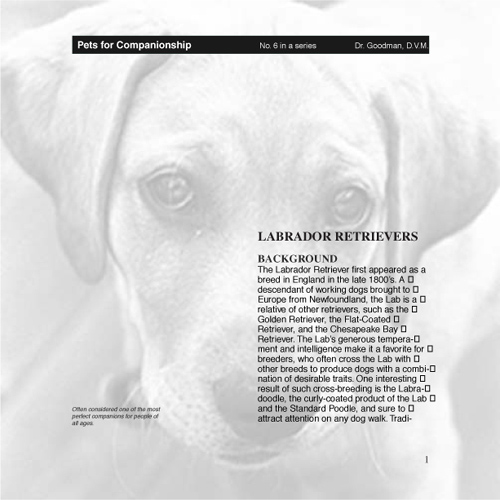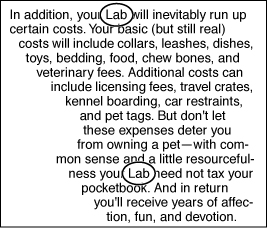Lesson 6. Document Editing
FrameMaker 7.0 includes several powerful editing tools: the Find/Change command (for finding and changing text and other items), a spelling checker (which can find and correct misspelled words and common typing errors), and a thesaurus (which defines words and provides synonyms, antonyms, and related words). To save typing and ensure consistency, you can use variables for words or phrases that appear in multiple places in a document.
In this lesson, you’ll learn how to do the following:
• Turn off the display of graphics in a document.
• Define and insert user variables.
• Change variable definitions.
• Use the Find/Change command to find and replace text.
• Use the Thesaurus to replace words with their synonyms.
• Use the Spelling Checker to find and correct spelling and typing errors.
Viewing the document
The text you’ll edit is in a veterinary article about Labrador Retrievers. To begin, you’ll open and view the article.
1. If necessary, copy the Lesson06 folder from the FrameMaker 7.0 Classroom in a Book CD and start FrameMaker 7.0.
2. If FrameMaker 7.0 is not in standard mode, choose File > Preferences > General, and then select FrameMaker from the Product Interface pop-up menu.
3. Open Editing.fm in the Lesson06 folder.

4. Choose File > Save As, enter the filename Editing1.fm, and click Save.
5. In the status bar, click the Next Page button (![]() ) to page through the document. The last page is page 4.
) to page through the document. The last page is page 4.
6. In the status bar, Shift-click the Previous Page button (![]() ) to go back to page 1.
) to go back to page 1.
Turning off the display of graphics
Throughout this lesson, you’ll select and edit text. To make pages display faster, and to make it easier to see the selected text, you’ll turn off the display of graphics.
1. Choose View > Options.
2. Turn off Graphics and click Set.

The graphics temporarily disappear from the document. (They won’t appear in print either.) They are not deleted—when you finish editing the text, you’ll redisplay the graphics.
3. If you like, page through the document to see how it looks without graphics. When you’re finished, go back to page 1.
4. If you find the text too small to read, click the Zoom In button (![]() ) in the status bar until the text is legible.
) in the status bar until the text is legible.
Defining a user variable
The name of the dog breed (Labrador Retriever) appears often in the article, as does a shorter version of the name (Labrador). The long name is already defined as a user variable.
A user variable is a placeholder for text, such as a technical term or name, that you can define once and use repeatedly in a document. When you change the definition, FrameMaker 7.0 updates the variable throughout the document. In this way, variables can help save you time and ensure consistency in your documents.
In this part of the lesson, you’ll create a user variable.
1. Click once on the heading, LABRADOR RETRIEVERS. The entire phrase (except for the S at the end) is selected, indicating that you can’t edit the variable as you do regular text.
First you’ll define a user variable for the short name. Then you’ll simply insert the variable rather than type the name yourself.
2. Choose Special > Variable.
3. Click Create Variable.
4. Enter ShortName in the Name text box, and enter Labrador in the Definition text box.
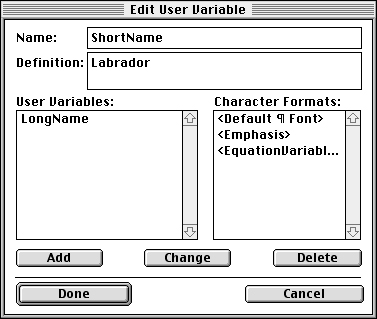
5. Click Add, and then click Done.
The new variable appears in the Variable dialog box.
6. Click Done.
Inserting variables
Now you’ll insert variables rather than type the text each time.
1. On page 1, double-click the word breed in the fourth line of body text to select the word.
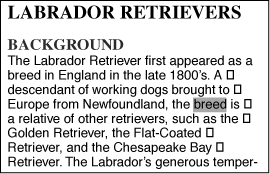
2. Choose Special > Variable.
3. In the Variables scroll list, select ShortName and click Replace. Labrador appears in place of breed.

Now you’ll insert another variable. This time, you’ll use a keyboard shortcut.
4. In the status bar, click the Next Page button (![]() ) to display page 2.
) to display page 2.
5. Near the bottom of the right-hand column, click just to the left of the word Few to place the insertion point.
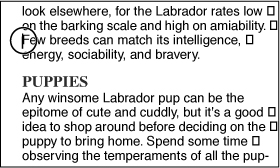
6. Type Nevertheless, the and press the spacebar.
7. Press Control+0 (zero). The status bar changes to prompt you for a variable name. (In Windows and on UNIX systems, the status bar displays the name of the first variable in the Variable scroll list.)
![]()
8. Type the letter S. Because only the ShortName variable begins with the letter S, the prompt changes to indicate that variable.
![]()
9. Press Return. The variable is added to the text.
10. Press the spacebar. Type remains one of the most popular breeds among dog lovers followed by a period and a space to end the sentence.
Finding and changing text
Because the article was typed before the ShortName variable was defined, the word Labrador still appears throughout the article as typed text rather than as a variable. You’ll change that by replacing occurrences of Labrador throughout the document with the ShortName variable.
First you’ll copy the ShortName variable to the Clipboard.
1. Go back to page 1.
2. In the fourth line of body text on page 1, click Labrador once to select the variable. (If you double-click by mistake, the Variable dialog box appears. Just click Cancel.)

3. Choose Edit > Copy. The variable is copied to the Clipboard.
4. Choose Edit > Find/Change.
5. Enter Labrador in the Find text box.
6. Choose By Pasting from the Change pop-up menu. This option lets you replace by pasting whatever you last copied—in this case, the ShortName variable.

7. Click Find. The next occurrence of Labrador on page 1 is selected.
8. Click Change & Find. The selected text is replaced with the variable, and the next occurrence is selected.
The article contains quite a few occurrences of the word Labrador, so you’ll have FrameMaker 7.0 replace them all at the same time.
9. Make sure that Look in Document is selected near the bottom right of the dialog box, click Change All, then click OK.
All the remaining occurrences of the word Labrador in this document are replaced by the ShortName variable. When FrameMaker 7.0 shows you the number of changes made in the document, click OK to dismiss the alert box. Page 4 of the article appears, with the insertion point in the last paragraph, just after the last occurrence of the variable.

10. Close the Find/Change dialog box.
Other ways to use Find/Change
You can use Find/Change and Find/Next commands to find many other items, not just text. For instance, you can choose Variable of Name from the Find pop-up menu and type the name of the variable to find or change. Or, you can specify a paragraph tag and its name to quickly find the next or previous instance of that paragraph format in your document.
Changing a variable definition
You’ll change the definition for the ShortName variable from Labrador to Lab. FrameMaker 7.0 will then make the change throughout the document.
1. Choose Special > Variable.
2. Select ShortName in the Variables scroll list and click Edit Definition.
3. Enter Lab in the Definition text box and click Change.
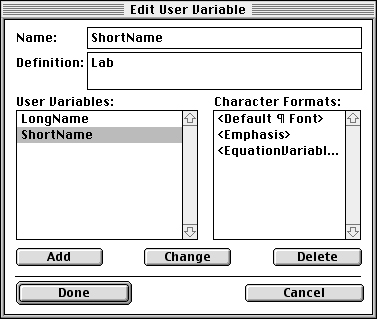
4. Click Done, and then click Done again. FrameMaker 7.0 replaces Labrador with Lab throughout the article.
![]() You can also import variable definitions from other FrameMaker documents using the File > Import > Formats command. This is a useful way to ensure consistency in a family of documents.
You can also import variable definitions from other FrameMaker documents using the File > Import > Formats command. This is a useful way to ensure consistency in a family of documents.
Using the Thesaurus
The FrameMaker 7.0 Thesaurus provides you with alternate words that have a similar meaning to the selected word. In this part of the lesson, you’ll replace the word faithfulness with a synonym from the Thesaurus.
1. Go back to page 1 of the article and double-click the word faithfulness near the middle of the first paragraph.

2. Choose Edit > Thesaurus.
3. The Thesaurus dialog box appears. It contains several definitions for faithfulness and a list of synonyms for each definition.

4. Click the word loyalty in the first Synonyms list. The Thesaurus dialog box now contains the definition and synonyms for loyalty.
Before you decide to use loyalty, you’ll try a word of your own.
5. Click Look Up. The Thesaurus Look Up dialog box appears.
6. Enter companionship in the Word text box and click Look Up.

7. The Thesaurus dialog box now contains the definition and synonyms for companionship.
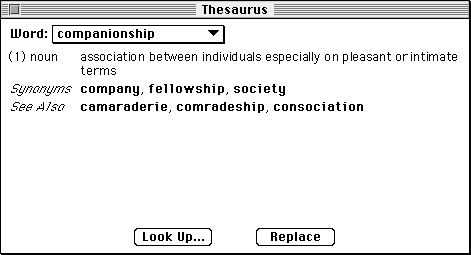
Unfortunately, companionship doesn’t seem close enough to the meaning you intend, so you’ll use loyalty instead.
8. In the Thesaurus dialog box, choose loyalty from the Word pop-up menu. (The words you’ve looked up recently appear in the pop-up menu.)
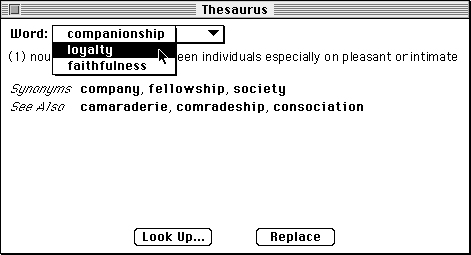
9. Click Replace.
Now you’ll check for other occurrences of faithfulness in the article. (Before continuing, you might want to move the Thesaurus dialog box away from the document window.)
10. Choose Edit > Find/Change. Enter faithfulness in the Find text box and click Find. The next occurrence is on page 2.

You can use loyalty here, too, but you’ll replace the entire phrase gentle faithfulness.
11. Shift-click the word gentle to extend the selection.
12. In the Thesaurus dialog box, click Replace.
13. In the Find/Change dialog box, click Find. There are no more occurrences of faithfulness in the article.
14. Click OK to dismiss the alert message. Then close the Find/Change dialog box and the Thesaurus dialog box.
Checking spelling
You’re almost finished with the article, so you’ll check the spelling next.
In this part of the exercise, you’ll use three dictionaries:
• The main dictionary contains words found in a standard dictionary. You can’t add or delete words in this dictionary.
• A personal dictionary contains words, that aren’t in the main dictionary, that you want FrameMaker 7.0 to allow when it checks any document on your computer. You can add and delete words in this dictionary.
• A document dictionary contains words that FrameMaker 7.0 allows in the current document, but aren’t found in the main or personal dictionaries. Unlike the other two dictionaries, the document dictionary isn’t a separate file; it’s part of the document. You can add and delete words in the document dictionary.
1. Go back to page 1.
2. Click in the heading BACKGROUND to place the insertion point.
3. Choose Edit > Spelling Checker.
4. Click Start Checking.
Because the first word found is not in any of the dictionaries, FrameMaker 7.0 selects the word temperment and suggests that it’s a misspelling. FrameMaker 7.0 recommends a spelling of temperament, and provides several other choices.
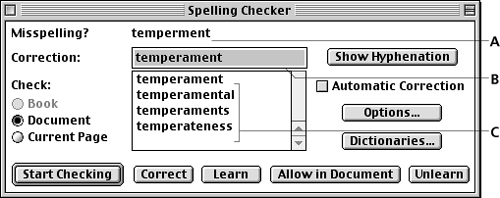
A. Suspected problem B. Recommended correction C. Additional choices
The suggested correction is the right one, so you’ll accept it.
5. Click Correct.
Next, FrameMaker 7.0 stops at the repeated words of of and suggests that only one of the words is necessary. This is a typing error rather than a spelling error.

6. Click Correct.
FrameMaker 7.0 now stops at Labradoodle, a word that describes a breed that hasn’t found it’s way into the dictionaries yet.
7. Click Allow in Document. FrameMaker 7.0 adds the word to the document’s dictionary. If Labradoodle appears elsewhere in this document, FrameMaker 7.0 won’t question it again.
This time, FrameMaker 7.0 stops at dogwalk. You’ll replace this with the two words dog walk.
8. Enter dog walk in the Correction text box and click Correct.
![]() You can also click on the word dogwalk to the right of Misspelling to add it to the Corrections text box, and then edit the word to dog walk.
You can also click on the word dogwalk to the right of Misspelling to add it to the Corrections text box, and then edit the word to dog walk.

Now FrameMaker 7.0 stops at furriness.
9. Enter fur in the Correction text box and click Correct.
10. FrameMaker 7.0 finds two spaces in a row and suggests replacing them with a single space.

11. Click Correct.
FrameMaker 7.0 next questions the word dysplasia. You want to allow this word in the article and in other articles that you’re writing.
12. Click Learn. FrameMaker 7.0 adds the word to your personal dictionary and won’t question this word in any document you spell-check.
Because FrameMaker 7.0 finds no more words that aren’t in its dictionaries, Spelling OK now appears in the Spelling Checker dialog box.

13. Close the Spelling Checker dialog box.
Viewing the finished article with graphics
You’ve finished editing the article, so now you’ll redisplay the graphics.
1. Choose View > Options.
2. Select the Graphics option and click Set. The graphics reappear.
3. Save and close Editing1.fm.
Moving on
You’ve completed this lesson. For in-depth information on the Find/Change, Spelling Checker, and Thesaurus commands, see Chapter 4, “Word Processing,” in the Adobe FrameMaker 7.0 User Guide. For in-depth information on variables, see Chapter 8, “Variables,” in the Adobe FrameMaker 7.0 User Guide.
Review questions
1. Why might you turn off graphics when editing a document? How do you hide and display graphics?
2. What is a user variable? Why should you use one?
3. How do you create a variable?
4. What does the Thesaurus do? How do you open it?
5. Describe three kinds of dictionaries FrameMaker 7.0 provides.
6. How do you open the spelling checker? Name the two types of errors the Spelling Checker detects.
Answers
1. Hiding graphics makes pages display faster, which can make it easier to edit text. To specify whether to display graphics, choose View > Options, select or turn off Graphics, and click Set.
2. A variable is a placeholder for text. Once you define a variable with text—such as with a product name or term—that text appears wherever you insert the variable in your document. If you change the definition later, FrameMaker 7.0 updates all occurrences of that variable in the document with the updated text. By changing the variable’s definition, you don’t have to retype or find and replace each occurrence of text you want to reuse. You also ensure that the text is used consistently in the document.
3. To create a variable, choose Special > Variable. Click Create Variable. Enter a name for the variable in the Name text box, and enter the variable text and character format(s) in the Definition text box. Click Add, then click Done. When the new variable appears in the Variable dialog box, click Done.
4. You use the Thesaurus to look up words with a similar meaning to the word you specify. To open the Thesaurus, choose Edit > Thesaurus.
5. The main dictionary contains words found in a standard dictionary. You can’t add or delete words in this dictionary.
A personal dictionary contains words that aren’t in the main dictionary, but that you want FrameMaker 7.0 to allow when it checks a document. You can add and delete words in this dictionary.
A document dictionary contains words that aren’t in the main dictionary or personal dictionary, but that you want FrameMaker 7.0 to allow in the current document. You can add and delete words in this dictionary. However, the document dictionary isn’t a separate file; it’s part of the document.
6. To open the Spelling Checker, Choose Edit > Spelling Checker. The Spelling Checker looks for misspelled words and typographical errors (such as repeated words).

